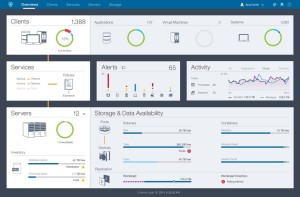IBM is targeting storage for hybrid clouds with Spectrum Protect. Specifically, it brings new cloud backup and a new management dashboard aimed to help businesses back up data to on-premises object storage or the cloud without the expense of cloud-gateway appliances. It also enables advanced data placement across all storage types to maximize performance, availability, and cost efficiency. Spectrum Protect represents the latest part of the IBM Spectrum storage family; which provides advanced software defined storage (SDS) storage capabilities and flexible storage either as software, an appliance, or a cloud service. IBM announced Spectrum Protect at the end of August.
Courtesy IBM: Spectrum Protect dashboard (click to enlarge)
Introduced early this year, IBM Spectrum brings a family of optimized SDS solutions designed to work together. It offers SDS file, object, and block storage with common management and a consistent user and administrator experience. Although it is based on IBM’s existing storage hardware products like XIV, Storwize, IBM FlashSystem, and SVC you can deploy it as software on some non IBM hardware too. It also offers support for VMware environments and includes VMware API support for VASA, VAAI, and VMware SRM. With Spectrum, IBM appears to have come up with a winner; over the last six months, IBM reports more than 1,000 new clients have chosen products from the IBM Spectrum Storage portfolio.
Specifically, IBM Spectrum Protect supports IBM Cloud infrastructure today with plans to expand to other public clouds in future. IBM Spectrum Accelerate (XIV block storage) also can be accessed as a service by IBM Cloud customers via the SoftLayer cloud infrastructure. There it allows companies to deploy block storage on SoftLayer without having to buy new storage hardware or manage appliance farm.
In competitive analysis, IBM found that a single IBM Spectrum Protect server performs the work of up to 15 CommVault servers. This means that large enterprises can consolidate backup servers to reduce cost and complexity while managing data growth from mobile, social, and Internet of Things environments. Furthermore, SMBs can eliminate the need for a slew of infrastructure devices, including additional backup servers, media servers, and deduplication appliances, thereby reducing complexity and cost. Cost analysis with several beta customers, reports IBM, indicates that the enhanced IBM Spectrum Protect software can help clients reduce backup infrastructure costs on average by up to 53 percent.
IBM reports that the Spectrum Storage portfolio can centrally manage more than 300 different storage devices and yottabytes (yotta=1024 bytes) of data. Its device interoperability is the broadest in the industry – incorporating both IBM and non-IBM hardware and tape systems. IBM Spectrum Storage can help reduce storage costs up to 90 percent in certain environments by automatically moving data onto the most economical storage device – either from IBM or non-IBM flash, disk, and tape systems.
IBM Spectrum Storage portfolio packages key storage software from conventional IBM storage products. These include IBM Spectrum Accelerate (IBM XIV), Spectrum Virtualize (IBM SAN Volume Controller along with IBM Storwize), Spectrum Scale (IBM General Parallel File System or GPFS technology, previously referred to as Elastic Storage), Spectrum Control (IBM Virtual Storage Center and IBM Storage Insights), Spectrum Protect (Tivoli Storage Manager family) and Spectrum Archive (various IBM tape backup products).
The portfolio is presented as a software-only product and, presumably, you can run it on IBM and some non-IBM storage hardware if you chose. You will have to compare the cost of the software license with the cost of the IBM and non-IBM hardware to decide which gets you the best deal. It may turn out that running Spectrum Accelerate (XIV) on low cost, generic disks rather than buying a rack of XIV disk to go with it may be the lowest price. But keep in mind that the lowest cost generic disk may not meet your performance or reliability specifications.
IBM reports it also is enhancing the software-only version of IBM Spectrum Accelerate to reduce costs by consolidating storage and compute resources on the same servers. In effect, IBM is making XIV software available with portable licensing across XIV systems, on- premises servers, and cloud environments to offer greater operational flexibility. Bottom line: Possibly a good deal but be prepared to do some detailed comparative cost analysis to identify the best mix of SDS, cloud storage, and hardware at the best price for your particular needs.
In general, however, DancingDinosaur favors almost anything that increases data center configuration and pricing flexibility. With that in mind consider the IBM Spectrum options the next time you plan storage changes. (BTW, DancingDinosaur also does storage and server cost assessments should you want help.)
DancingDinosaur is Alan Radding, a veteran IT analyst and writer. Please follow DancingDinosaur on Twitter, @mainframeblog. See more of his IT writing at technologywriter.com and here.

